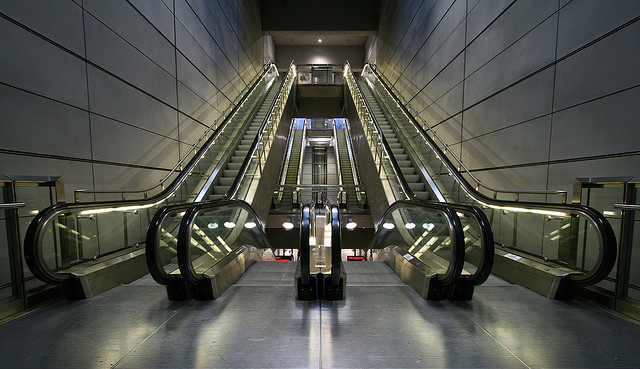
- Photo by Stignygaard
Life is full of unspoken rules. These rules can be hard to figure out if you’re an outsider. Yet, when followed they tend to drastically improve the flow and efficiency of group activities. When violated, you not only risk drastically reducing the system’s efficiency, but also pissing off a large number of people in the process. Here are a few general tips for improving your public transportation experience.
General Traffic Flow
Foot traffic typically follows the same basic rules (flow wise) as vehicle traffic. While this isn’t particularly important in wide open spaces, when confined to stairways, on escalators and in other like-kind situations this becomes extremely important. While left vs right varies from country to country you can typically figure out the appropriate place to walk by pausing briefly to observe locals. A good rule of thumb tends to be that pedestrian traffic will mimic automotive traffic. This is particularly important on stairways where one side is used for traffic heading up and the other is used for traffic heading down.
Escalators
These are perhaps one of the most rule centric areas of public transportation. The cardinal rule of escalator traffic is that slow/stopped traffic should always stand to the right. Yes, this holds true even if you’re in the middle of a conversation with a friend. If you’re stationary or moving slowly on a moving walkway or escalator stand to the right, single file, while leaving space for people in a hurry to pass on your left. It’s just like the highway – the left lane is the passing late. If you’re in it and not passing you’re a road hazard and can expect to get tailgater…or worse. If your conversation can’t wait, then turn sidewise and have a discussion with the person in-front/behind you. The only exception to this rule is when there’s a significant traffic backlog in which cases space use efficiency becomes more important.
Many metros, like those here in Copenhagen, have double escalators to handle the heavy flow. In these instances both escalators may be transporting people in the same direction (up/down). Keep in mind that both escalators are not the same. The same traffic flow rules apply here. If you’re not in a hurry then stick to the escalator to the right side. If you’re in a hurry or will be walking part of the time, then aim for the one on the left.
Boarding Trains/Subway Cars
For some inexplicable reason most of us can’t help but rush to board public transportation when it arrives. I know I’m guilty of this as well. Unfortunately, this usually results in a traffic jam as people end up so focused on boarding that they fail to let the people trying to get off of the train/tram/etc. disembark.
When the train/subway arrives people waiting to board should wait to either side of the door(s) leaving a path for departing passengers. It is especially important that you do not stand/line up directly in-front of the door. Only when the final passengers disembark is it acceptable to start making your way on board. Just because there’s an open space immediately in front of the doors doesn’t mean you “lucked out” and get to be first in line.
Mothers, the Elderly, Injured and Disabled
While people seem to remember that eating with their mouths full is impolite, it appears that proper etiquette on public transportation is a whole different matter. We all love to find that coveted seat on the bus or subway. It sucks to give it up, but let’s keep things in context. When you see a mother carrying a young child, an older person, someone on crutches or similarly injured, or the disabled don’t wait for them to ask, don’t ignore them, and definitely don’t shrug it off as their tough luck. Do your best to give them your seat, or at the very least offer it. There’s a spectrum here. The younger you are and the better shape you’re in, the more important it is that you’re the first one to offer up your seat. Think of it as a competition. Besides, it’ll feel good knowing you’ve made someone’s day a bit easier and that you’ve done a good deed.
These rules vary slightly from culture to culture and are more prevalent in most western countries. It’s worth noting that most of these rules don’t apply in a lot of major Asian cities where it tends to be far more cutthroat and physical. Be mindful of your destination and take an extra minute or two to figure out how the system works. While there’s no one to force you to follow the rules discussed in this post, don’t be surprised at the stray elbows and brusque treatment you may find if you don’t.
Are there rules I missed or do you have stories about where a rule violation went wrong? Please tell us a bit about them!